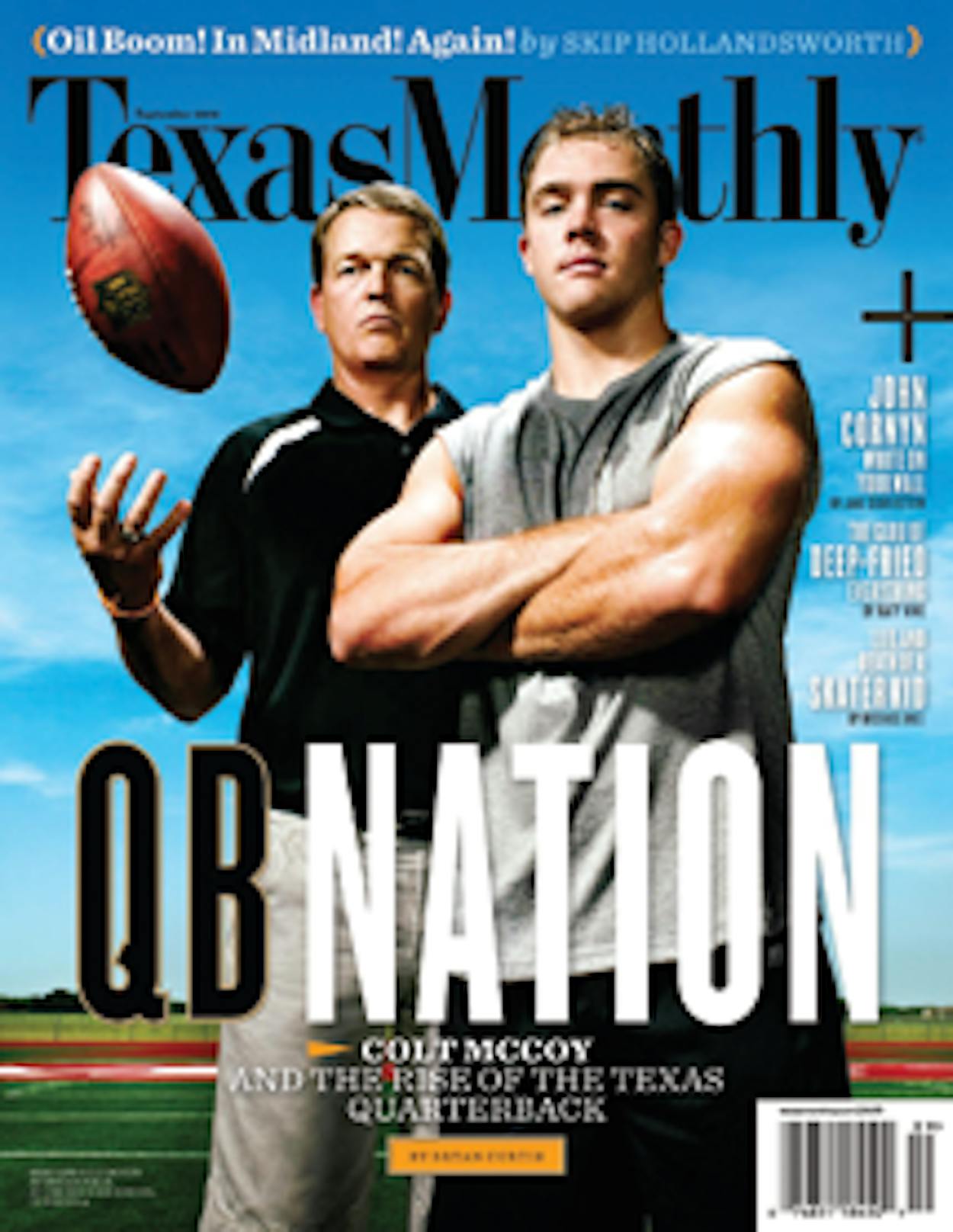Quarterback Sneaks
While Bryan Curtis’s piece on Texas quarterbacks sure got me in the mood for some pom-poms and pigskin, missing among the photos was former Stephenville High and University of Houston gunslinger Kevin Kolb [“Arms Race,” September 2010]. The Philadelphia Eagles QB certainly merits a nod over some of the backups pictured.
David Raffetto
Houston
Your listing of famous Texas passers was encyclopedic and would have been perfect had it included San Antonio’s Chase Clement. He deserves mention, along with other Rice greats at that position, Tommy Kramer and Frank Ryan.
Tom Williams
Canyon Lake
How in the world do you write a story about Texas quarterbacks and not mention Kyle Padron at SMU?
Scott Remphrey
via e-mail
Oil’s Well That Ends Well
“That’s Oil, Folks” accomplished something almost unheard of in journalism: a well-balanced, in-depth story with clear explanations about oil field practices [September 2010]. Thank you, Skip Hollandsworth, for telling a great story with some wonderful characters who obliterated many stereotypes we’ve come to accept.
Richard Trout
Seminole
Holy Cow
Reading about how to cook barbacoa brought back wonderful memories of my dad and my tíos’ Christmas Eve tradition [The Manual, September 2010]. They would prepare la cabeza and dig el pozo on December 23. To prepare la cabeza they would wash it, wrap it in foil, wrap it in a wet burlap sack, and then stick it in a large lard can with a lid. La cabeza was then buried in el pozo and left to be cooked overnight.
The grown-ups had a great time with this annual ritual, but the kids had a hard time falling asleep at night after seeing la cabeza sitting in the kitchen sink. To us, it was El Cucuy, the boogeyman. When I closed my eyes, I could see the ghostly white head and the transparent skin with the veins showing through.
On Christmas Eve, when our parents loaded their tortillas with barbacoa, lengua, and sesos, we thanked our lucky stars that Mami had also made tamales. No scary stuff in tamales. We knew because we had helped.
Christmas morning brought the smell of roasting turkey, a heavenly scent to sleepy kids who had dreamed of being chased by El Cucuy until the wee hours of the night. Thinking about all this brings a smile to my face. Growing up Tex-Mex was a beautiful adventure.
Edna Campos Gravenhorst
San Antonio
Budget Busting
Editors’ Note: In our October issue senior executive editor Paul Burka was tasked with the same unenviable job facing our legislators: to balance the state budget. His cuts and suggestions have elicited a great deal of reader feedback, from everyday Texans and the heads of state agencies alike, a sampling of which we’ve excerpted below. We’ll run more of it in the December edition of Roar of the Crowd, and in the interim you can continue to follow the discussion between Paul and his readers on BurkaBlog, at texasmonthly.com.
Burka, there’s hope for you yet! The Legislature needs to be locked in a room and beaten over the head with your article [“The Eighteen Billion Dollar Man”]. I thought I’d never say this but “Burka for Gov . . .” Well, maybe that’s a bit much. But you have my vote for state comptroller.
Rex Freriks
Stinnett
I appreciate Mr. Burka’s theoretical exercise to reduce the state budget; however, I disagree with his recommendation to eliminate the Public Utility Commission. Electricity and telecommunications are basic services that allow Texans to achieve our current high standard of living. The PUC’s mission is to protect customers, foster competition, and promote high-quality infrastructure—clearly contrary to Mr. Burka’s statement that the PUC has “essentially nothing to do.” Elimination of the PUC would jeopardize consumers, competition, and existing and proposed infrastructure.
The claim that the PUC is spending $250 million on “something that has already been accomplished through deregulation” is incorrect. Of the PUC’s $266 million biennial appropriation (already reduced by 5 percent from its budgeted amount), about $239 million, or 90 percent, is earmarked to provide electric bill discounts to low-income customers. The remainder of the PUC’s appropriation, about $14.3 million, is used to pay the PUC’s 185 employees and fund our various programs.
Ironically, the PUC actually makes money for the state. For example, under state law, utilities are charged a Public Utility Gross Receipts Assessment, which brings in approximately $60 million per year to general revenue. In addition, since January 1, 2007, the PUC has assessed more than $31 million in administrative penalties, all of which is also paid into general revenue.
Despite Mr. Burka’s assertion, the PUC still has much to do in Texas. For instance, right now the commission is reviewing more than two dozen permits to build more than 2,300 miles of high-capacity transmission lines, from West Texas and the Panhandle to the I-35 corridor, to facilitate the delivery of renewable energy to Texans.
While a lighthearted attempt at cutting billions of dollars from the state budget is perhaps a worthy task, purported budget figures for the PUC and the job it performs for Texans include factual inaccuracies and incorrect assumptions and could ultimately lead your readers to erroneous conclusions. It is frustrating to read Mr. Burka’s tome when ten minutes of discussion with me or my colleagues would have informed him of what we really do at the PUC. Perhaps had he been better informed he would have reconsidered his choice to eliminate an agency that ensures the protection of vital services to all Texans. For a more concrete way to save money, the article could have highlighted how the PUC instituted an expense policy, in July 2009, that has saved almost $500,000 (versus budget). An example of our cost-cutting efforts is “cancel or eliminate periodical subscriptions.”
Barry Smitherman
Public Utility Commission chairman
Austin







